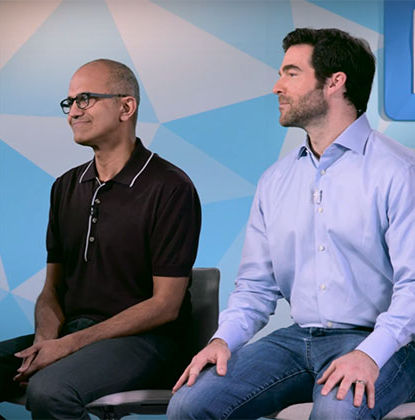TUESDAY JUNE 14, 2016

Microsoft CEO Satya Nadella (left) with LinkedIn CEO Jeff Weiner in a promo clip announcing the deal
- 2015 revenue: $US2.99b (2014: $US2.2 billion)
- 2015 bottom line: $US164.8m loss (2014: $US15.7m loss)
- Users: 433 million (including 1m+ in NZ)
Microsoft
- 2015 revenue: $US93b (2014: $US86.8)
- 2015 bottom line: $12.1b profit after $US7.6 write-down for failed Nokia purchase (2014: $US22.0 billion)
- Cash: $US117 billion (Microsoft says its all-cash purchase of LinkedIn will be funded “primarily with new debt”)
Microsoft has entered an agreement to buy LinkedIn for $US26.2 billion in cash.
The surprise deal represents a 50% premium on Nasdaq-listed LinkedIn’s closing price before the deal was announced.
The news sent the professional network site’s shares
Microsoft shares [NAS:MSFT] fell nearly 3% as the logic of the deal eluded some investors – and I dare say it will baffle some users too, given LinkedIn has alienated some in recent times with its ever-more hyperactive updates, and its poor communication over a data breach.
Link it into Office, CRM
One US analyst, Brad Reback of Stifel Nicolaus & Co, told the Wall Street Journal that Microsoft may find ways to generate revenue from LinkedIn’s professional network that LinkedIn couldn’t independently.
Connecting LinkedIn directly to Microsoft Office could help attendees of meetings learn more about one another directly from invitations in their calendars, he says. Sales representatives could pick up useful tidbits of background on potential customers from LinkedIn data.
And although Reback doesn’t say it, connecting LinkedIn to Dynamics (Microsoft’s competitor to Salesforce in the customer relationship management or CRM market) would be another obvious move.
Local cloud computing commentator Ben Kepes tells NBR the deal is “all about the data” — specifically, the treasure trove of data LinkedIn holds on its members. Will Microsoft be able to exploit it for gain with annoying LinkedIn users?
Microsoft CEO Satya Nadella says “work today is split” between tools such as Microsoft’s Office programs workers use to get their jobs done and professional networks that connect workers. The deal, he said, aims to weave those two pieces together.
“It’s really the coming together of the professional cloud and the professional network,” he says.
LinkedIn boss Jeff Weiner chips in: “Imagine a world where we’re no longer looking up at tech titans such as Apple, Google, Microsoft, Amazon and Facebook and wondering what it would be like to operate at their extraordinary scale – because we’re one of them.” (Scroll down to watch the pair’s official announcement.)
The shape of LinkedIn
LinkedIn reported $US2.99 billion in revenue for 2015, a 35% increase from a year earlier, while its loss widened to $US164.8 million from the year-ago $US15.3 million on a surge in costs related to sales and marketing and product development.
The professional network claimed 433 million users in its most recent quarterly filing, up from the previous quarter’s 413 million. In New Zealand, it claims more than one million users.
However, one report says only 25% of LinkedIn members use the site monthly.
And only a small minority pay for premium accounts. Paying users can message others who are not directly connected to them (a useful tool for recruiters) and view profiles anonymously (a useful tool for stalkers).
As every member is aware from special emails about companies who are looking for “candidates like you,” LinkedIn also runs recruitment advertising.
Don’t mention the N word
The LinkedIn deal is the largest in Microsoft’s history.
The company’s shareholders will be hoping it works out better than its last two mega-purchases: Nokia and Skype.
In September 2013, Microsoft bought Nokia’s phone business for $US7.2 billion.
But the deal failed to turn around the fortunes of Windows-based handsets.
iPhone and Android steam-rolled on, and in 2015 Microsoft wrote off $US7.6 billion in costs related to the deal and laid off 7800 (mostly ex-Nokia) staff. In May this year, it recouped a paltry $US350 million by onselling part of its phone business to Taiwan’s Foxconn.
In 2011, Microsoft bought Skype for $US8.5 billion. Skype remains popular but, even now, Microsoft is struggling to monetise the consumer version or integrate it smoothly with other Microsoft services, and it merely replicated existing features in Microsoft’s existing calling and videoconferencing products for business.
Other Microsoft acquisitions include Mojang (maker of Minecraft) in 2014 for $US2.5 billion, and Yammer for $US1.2 billion in 2012 — but some commentators say the once-hot corporate chat app has fallen into neglect.
Microsoft will be hoping to do better from LinkedIn but nevertheless could afford another stiff.
Ahead of the deal, it had $US117 billion in cash, and it will issue bonds to cover its purchase of LinkedIn.
The deal is subject to shareholder and regulatory approval, a process expected to take up to 12 months.
LinkedIn will face a $US725 million penalty payment to Microsoft if it backs out in the interim.
Assuming the deal does go ahead, Mr Nadella says he’ll let LinkedIn operatate at “arm’s length”
